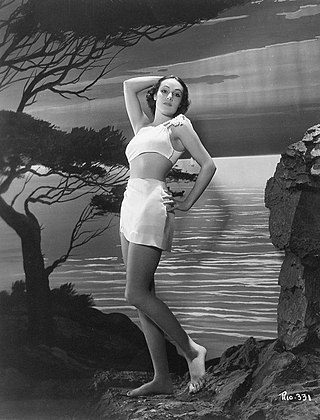
A bikini is a two-piece swimsuit primarily worn by girls and women that features one piece on top that covers the breasts, and a second piece on the bottom: the front covering the pelvis but usually exposing the navel, and the back generally covering the intergluteal cleft and a little, some, or all of the buttocks. The size of the top and bottom can vary, from bikinis that offer full coverage of the breasts, pelvis, and buttocks, to more revealing designs with a thong or G-string bottom that covers only the mons pubis, but exposes the buttocks, and a top that covers only the areolae. Bikini bottoms covering about half the buttocks may be described as "Brazilian-cut", while those covering about three-quarters of the buttocks may be described as "cheeky" or "cheeky-cut". In May 1946, Parisian fashion designer Jacques Heim released a two-piece swimsuit design that he named the Atome ('Atom') and advertised as "the smallest swimsuit in the world". Like swimsuits of the era, it covered the wearer's belly button, and it failed to attract much attention. Clothing designer Louis Réard introduced his new, smaller design in July. He named the swimsuit after the Bikini Atoll, where the first public test of a nuclear bomb had taken place four days before. His skimpy design was risqué, exposing the wearer's navel and much of her buttocks. No runway model would wear it, so he hired a nude dancer from the Casino de Paris named Micheline Bernardini to model it at a review of swimsuit fashions.

A swimsuit is an item of clothing designed to be worn by people engaging in a water-based activity or water sports, such as swimming, diving and surfing, or sun-orientated activities, such as sun bathing. Different types may be worn by men, women, and children. A swimsuit can be described by various names, some of which are used only in particular locations or for particular types of suit, including swimwear, bathing suit, bathing attire, swimming costume, bathing costume, swimming suit, swimmers, swimming togs, bathers, cossie, or swimming trunks, besides others.
Speedo International Limited is an Australian-British distributor of swimwear and swim-related accessories based in Nottingham, England, known for its swim briefs. The company has roots in Australia but is not based there anymore. Founded in Sydney in 1914 by Alexander MacRae, a Scottish emigrant, the industry-leading company is now a subsidiary of the British Pentland Group. Today, the Speedo brand can be found on products ranging from swimsuits and goggles to wristwatches. The Speedo brand was previously manufactured for and marketed in North America as Speedo USA by PVH, under an exclusive perpetual licence, which had acquired prior licensee Warnaco Group in 2013. As of January 2020, the Pentland Group purchased back the rights from PVH for $170 million in cash, subject to regulatory approval.
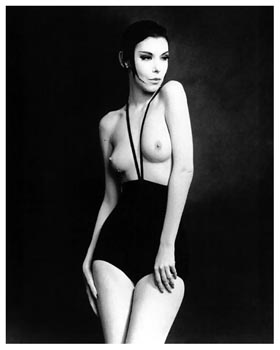
The monokini was designed by Rudi Gernreich in 1964, consisting of only a brief, close-fitting bottom and two thin straps; it was the first women's topless swimsuit. His revolutionary and controversial design included a bottom that "extended from the midriff to the upper thigh" and was "held up by shoestring laces that make a halter around the neck." Some credit Gernreich's design with initiating, or describe it as a symbol of, the sexual revolution.

A one-piece swimsuit most commonly refers to swimwear worn primarily by women and girls when swimming in the sea or in a swimming pool, playing water polo, or for any activity in the sun, such as sun bathing. Today, the one-piece swimsuit is usually a skin-tight garment that covers the torso, although some designs expose the back or upper chest.
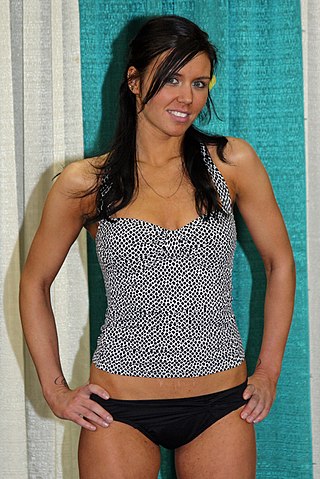
The tankini is a bathing suit combining a tank top, mostly made of spandex-and-cotton or Lycra-and-nylon, and a bikini bottom introduced in the late 1990s. This type of swimwear is considered by some to provide modesty closer to a one-piece suit with the convenience of a two-piece suit, as the entire suit need not be removed in order to use a toilet. Tankinis come in a variety of styles, colors, and shapes, some include features such as integrated push-up bras. It is particularly popular as children's beachwear, and athletic outfit good enough for a triathlon. According to Katherine Betts, Vogue's fashion-news director, this amphibious sportswear for sand or sea lets users go rafting, play volleyball, and swim without worrying about losing their top.
Rose Marie Reid, born Rose Marie Yancey, was a successful Canadian-born American swimsuit designer from the 1940s–60s.
Catalina is a brand of women's swimwear. It was once one of the oldest clothing manufacturers in California. Their history began in 1907, as Bentz Knitting Mills, a small manufacturer of underwear and sweaters. The name was changed to Pacific Knitting Mills in 1912, accompanied by the introduction of swimwear to their existing knit lines. The name was changed again finally to Catalina in 1928.
Jantzen is a brand of swimwear that was established in 1916 and first appeared in the city of Portland, Oregon, United States. The brand name later replaced the name of the parent company that manufactured the branded products. The brand featured a logo image of a young woman, dressed in a red one-piece swimsuit and bathing hat, assuming a diving posture with outstretched arms and an arched back. Known as the Jantzen "Diving Girl", the image in various forms became famous throughout the world during the early twentieth century.

Jacques Heim was a French fashion designer and costume designer for theater and film, and was a manufacturer of women's furs. From 1930 to his death in 1967, he ran the fashion house Jacques Heim, which closed in 1969. He was president of the Paris Chambre Syndicale de la haute couture from 1958 to 1962, a period of transition from haute couture to ready-to-wear clothing.

Many stylistic variations of the bikini have been created. A regular bikini is a two-piece swimsuit that together covers the wearer's crotch, buttocks, and breasts. Some bikini designs cover larger portions of the wearer's body while other designs provide minimal coverage. Topless variants are still sometimes considered bikinis, although they are technically not a two-piece swimsuit.

Evidence of bikini-style women's clothing has been found as early as 5600 BC, and the history of the bikini can be traced back to that era. Illustrations of women wearing bikini-like garments during competitive athletic events in the Roman era have been found in several locations, the most famous of which is at Villa Romana del Casale.
Mary Ann DeWeese (1913–1993) was an American sportswear designer. Appliquéd swimsuits and matching his-and-hers swimwear and sportswear are among the fashion firsts credited to DeWeese.
Rod Beattie (1959) is an American swimwear designer. His swimsuit designs are sold at stores throughout the United States. Beattie designed for La Blanca and Anne Cole Collection for 25 years. He launched his own swimwear label, "Bleu/Rod Beattie", in the summer of 2011.
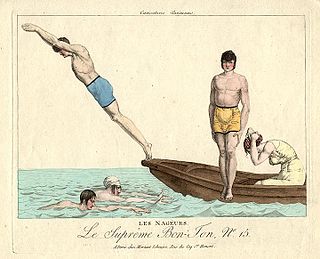
The history of swimwear traces the changes in the styles of men's and women's swimwear over time and between cultures, and touches on the social, religious and legal attitudes to swimming and swimwear.
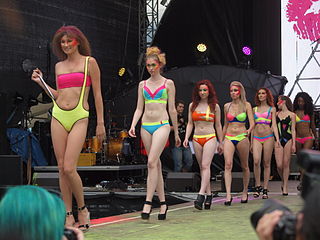
Women's beachwear fashion developed during the 19th and 20th centuries as rail travel became available in Europe and mass tourism became widespread. The beach in particular became a holiday destination where people could relax. The inhabitants of large industrial cities took to vacationing in locations that provided a contrast to their home areas. The practice spread worldwide and wealthy women desired new stylish outdoor garments to wear.

Anne Cole is an American swimwear brand most known for the invention of the tankini, a type of swimsuit. The brand's namesake founder, Anne Cole (1926–2017), was the woman who invented the tankini in 1998.

Fred Cole, born Frederick Cohn, was an American leader in women's swimwear fashions in the 20th century. As Frederick Cole he had a brief career as an actor in silent films before joining the family business, which he eventually transformed into the Cole of California brand.
Margit Felligi or Margit Felligi Laszlo was an American clothing designer, notable for her work with Cole of California in swimwear.
The Cole House was designed in 1957 by architect Harry Gesner for swimwear executive Fred Cole, in Los Angeles, California.











